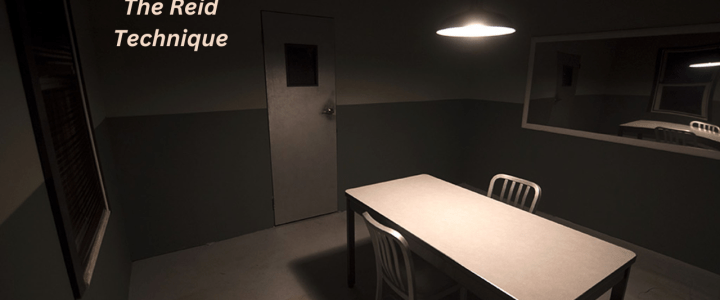The Reid Technique is a 9 step police interrogation method, which is the final phase of a 3 phase interrogation process.
The Confrontation
The detective starts the interrogation by presenting evidence, whether it be real or fake, on why the police have led to the decision that the suspect is in fact a suspect. The detective can move throughout the room and invade the suspect’s personal space. They present the evidence in confidence the entire time. The suspect’s level of stress may start to increase. They may start fidgeting or grooming themselves as well.
The Justification
The detective, in a soothing or soft voice to lure the suspect into a false sense of security, establishes stories or themes on why the suspect might have committed the crime. The detective could move the blame away from the suspect, and put it onto another person’s circumstances that could justify why the suspect committed the crime. The detective looks for excuses that may be brought up from the suspect many times. The theme or story that the detective brings up may change to see if the suspect likes one scenario more than another. For example, if the suspect nods their head, or if they seem to pay more attention during one scenario than the other.
Denial Interruption
During the entire investigation, the suspect may start producing denial of any guilt. Detectives need to stop this as it could increase the suspect’s confidence. The detective will kindly interrupt the suspect in their denial, saying things like they will be given a turn to talk in a moment, but right now they need to listen. A low amount of denials tells the detective that there is an sign of guilt, and they are on the right track to getting the suspect to confess.
Overruling objections
Once the suspect fully latches onto a story that the detective produced, the suspect may begin to throw out objections. The detective should treat these differently than simple denials, and should try to turn them against the suspect. They use the opportunity to get the suspect to move towards the acknowledgement of their crime. When done correctly, the suspect’s objection can be turned into an admission of guilt.
Reinforcing Security
At this point, the suspect may begin to feel unsure, and start to be unreceptive. The detective should start the phase of reinforcing security. The detective starts to pretend to be the suspect’s ally, and will act more sincere. The detective may use physical gestures such as patting the suspects back, or putting his hand on their shoulder.
Indications of Surrender
The suspect could begin to buckle under the stress. They could hunch their shoulders, or put their head in their hands. To increase the level of stress in the suspect, the detective may make eye contact with the suspect. If the suspect begins to cry, this indicates to the detective an indicator of guilt. The detective will use these insecurities to transition to the next step, which are the two alternatives.
The Two Alternatives
The detective proposes two alternatives on why the suspect might have committed the crime. One alternative is more socially acceptable to society, so the suspect is expected to choose that one. It doesn’t matter which alternative the suspect chooses, as they both admit guilt. The detective hides a third alternative from the suspect, which is where the suspect maintains that they did not commit the crime.
Bringing Witnesses
The detective is then ready for the admission of guilt. Yet, before that can happen, the detective brings in one or more witnesses. Sometimes the detective steps out entirely and makes the suspect confess to a different person. All this is done to keep the suspect’s stress level high provides a way for the truth to come out from the suspect easily.
The Confession
At the end of the interrogation, the detective records the suspect’s admission. This can be done by video, audio, or any other means of recording.
TL;DR
The Reid Technique is a common and easy tool that detectives use for interrogation. It’s many steps work together to increase the suspect’s stress level and to get closer to a confession. Although it is a very common tool, it is not 100% fool proof and has led to false confessions. In conclusion, The Reid Technique is a high risk, high reward method of interrogation.

